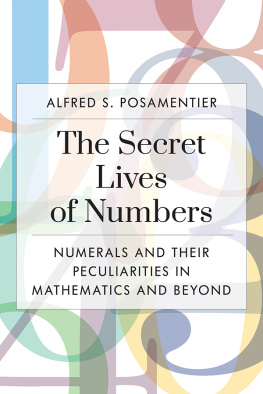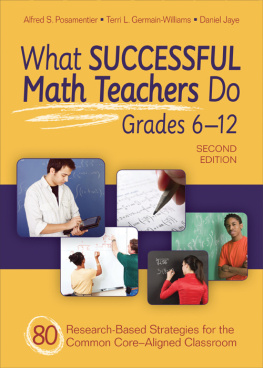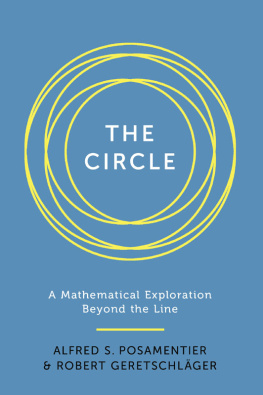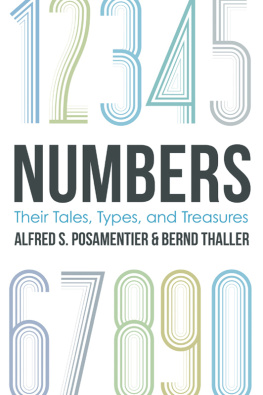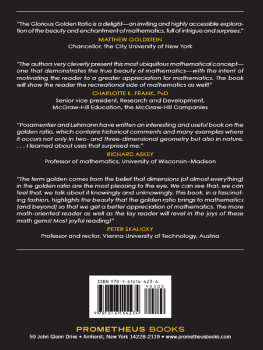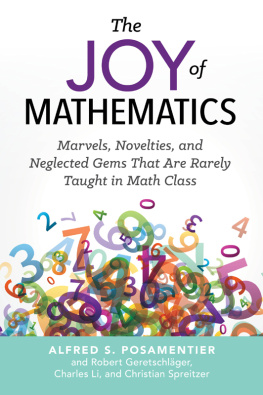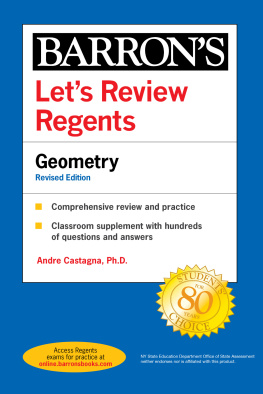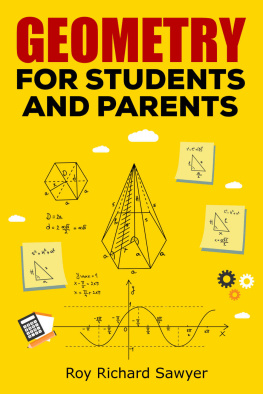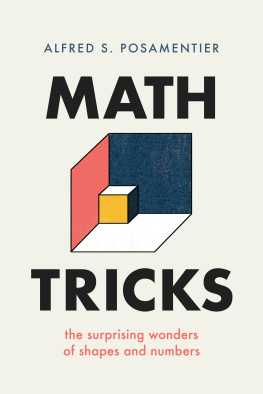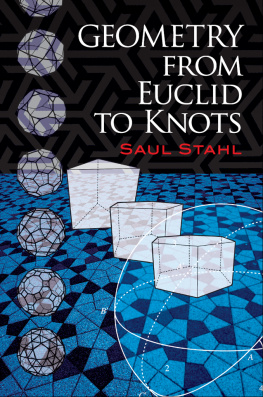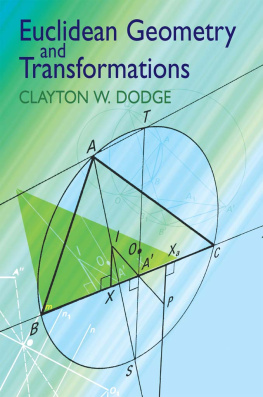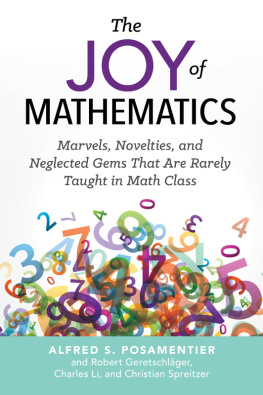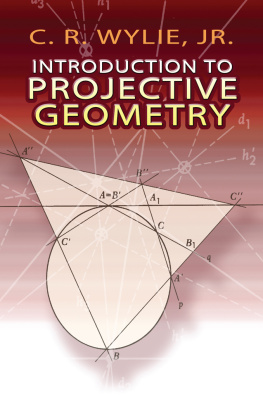ABOUT THE AUTHORS
ALFRED S. POSAMENTIER is currently Dean of the School of Education and Professor of Mathematics Education at Mercy College, New York, and was previously Distinguished Lecturer at New York City College of Technology of the City University of New York. He is Professor Emeritus of Mathematics Education at The City College of The City University of New York, and former Dean of the School of Education, where he was for forty years. He has been Visiting Professor at several European universities in Austria, England, Germany, the Czech Republic, and Poland, while at the University of Vienna he was Fulbright Professor (1990). He has taken on numerous important leadership positions in mathematics education locally. He was a member of the New York State Education Commissioners Blue Ribbon Panel on the Math-A Regents Exams, and the New York State Commissioners Mathematics Standards Committee, which redefined the Standards for New York State, and he also served on the New York Citys Schools Chancellors Math Advisory Panel. Dr. Posamentier is the author and co-author of more than fifty-five mathematical books for teachers, secondary and elementary school students, and the general readership. He is also a frequent commentator in newspapers and journals on topics relating to education.
ROBERT L. BANNISTER is the educational consultant to the President at St. Louis University High School, St. Louis, Missouri. Prior to this, he served as Mathematics teacher and then Associate Principal at Horton Watkins High School, Ladue, Missouri before becoming the Principal at St. Louis University High School. He has taught Middle School, High School and University Mathematics classes and worked as a High School Mathematics editor. He assisted in the development and formation of several Middle Schools in St. Louis for under-served students. He also has served on a variety of Civic and Cultural associations Boards. He helped to develop an individualized and innovative Mathematics program while at Horton Watkins High School as well as contributed to and taught a Mathematical Research program for St. Louis Universitys graduate students. He is still involved in Mathematics classes at St. Louis University High School when their teachers need assistance.
PREFACE / To the Student
This book was written for you to read and enjoy. It is a logical development of a body of mathematical knowledge known as geometry. Included in this book are topics from plane geometry, solid geometry, coordinate geometry, vector geometry, and non-Euclidean geometry, the latitude of which can enhance your interest of geometry.
How does one read and study a geometry book? You will find that each new concept in the book is carefully developed and then clarified and reinforced with many examples. In addition, there are over 2,000 illustrations to help you visualize the conditions of the problems. Prior to each set of exercises, there are numerous examples with their solutions completely worked out in detail. Before attempting to start any assignment, you should read the text and study the sample solutions that precede the exercises. The Class Exercises that appear in each section will also help you to understand the concepts of the sections more clearly. Study this material with pencil at hand, supplying illustrations where they are not provided. If necessary, reread the section that precedes the exercises.
Within each chapter are inserts to be used as supplementary reading, to enrich your understanding of geometry. These come under the headings A Look at the Past and Something to Think About. You will find the course far more interesting if you take the time to read and explore these ideas. Further supplementary material is given at the conclusion of selected chapters in the sections entitled Mathematical Excursion. This material is definitely more challenging and has been prepared for those of you with special interests and abilities in mathematics.
Also included at the end of each chapter is a vocabulary list, a set of review exercises, a chapter test, and topics for suggested research. These should help you to organize and evaluate your knowledge before going on to new work.
The cumulative review at the close of every three chapters is a unique feature of this text. The reviews are designed for self-evaluation, and you should enjoy the experience of working through these.
The study of mathematics can be an exciting and rewarding experience. We wish you luck as you begin this study of geometry.
The authors
GEOMETRY
Its Elements & Structure
SECOND EDITION
Alfred S. Posamentier
Robert L. Bannister
DOVER PUBLICATIONS, INC.
Mineola, New York
Introduction to the Dover Edition
The time-honored geometry course typically taught in high schools over the last hundred years has a long history and is clearly unique to the United States. Today it is manifested within the Common Core State Standards. Although most believe that this course stems largely from Euclids elements, it would probably be more accurate to say that the geometry book published in English by the Scottish mathematician Robert Simson (16871768), and which remained in print for well over one hundred years, had probably the greatest influence on our one-year-long high school study of geometry. He supported the Euclidean style and shied away very directly from that of Rene Descartes (15961650). Perhaps one of the greatest influences for introducing this Euclidean geometry course in high schools was the geometry book by Charles Davies (17981876), a professor at Columbia College, New York. Yet he attributes his work to that of the French mathematician AdrienMarie Legendre (17521833). However it got here, this book provides a course in the deductive development of geometry, which has gone through a number of changes over the past fifty years. But this book captures these many modifications and is completely consistent with the current mathematics standards in the United States.
The book has many features that will aid in truly appreciating the beauty of geometry, with many interesting exercisesfrom rather simple to quite challenging, separated by sectional rankings A, B, and C. It is particularly noteworthy to consider how each theorem is presented and developed, often-time through class exercises intended to explore the ensuing theorem. It would be wise to consider these details as it will make the material far more intelligible.
Enrichment is a very important aspect of teaching any subject matter. Towards that end we offer Mathematical Excursions throughout the book, which are intended to allow the reader to expand in areas beyond the curriculum. There are a number of other special features in the book such as historical notes (A Look at the Past) that will help students appreciate the mathematics being presented as well as some other shorter enriching topics under the heading of Something to Think About.
With Chapter Thirteen the book extends beyond plane surfaces dealt with previously to consider the surface areas and volumes of solids. The last two chapters offer alternative approaches to geometry, one through the study of vectors, and the other departing from Euclidean geometry into what is known as non-Euclidean geometry.
We hope that you will enjoy this rather comprehensive treatment of geometry, which is the equivalent of the high school geometry course with some features allowing the reader to expand beyond that realm.
Alfred S. Posamentier, April 2014
Copyright
Copyright 1972, 1977, 2014 by Alfred S. Posamentier and Robert L. Bannister
Introduction to the Dover Edition Copyright 2014
by Alfred S. Posamentier


